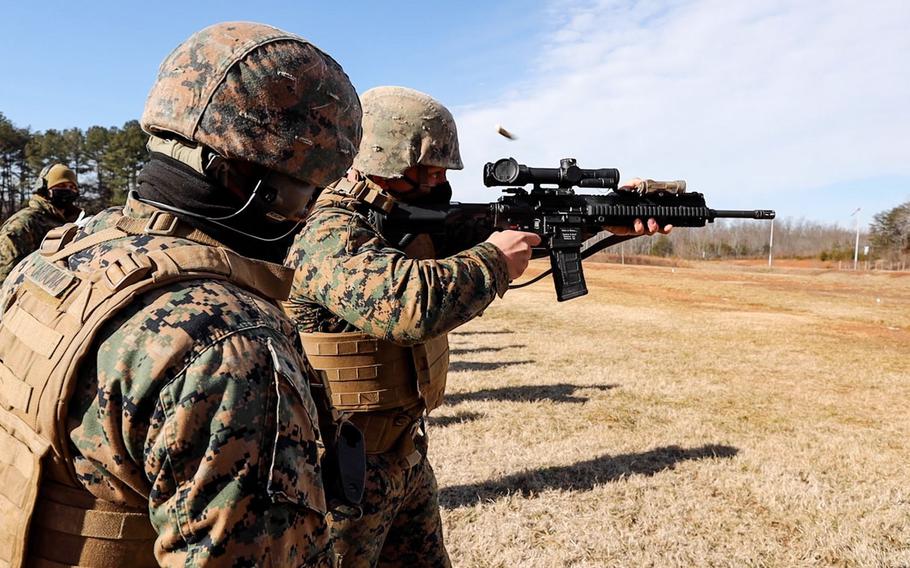
Marines with Weapons Training Battalion conduct the Annual Rifle Qualification train-the-trainer course on Marine Corps Base Quantico, Va., Feb. 17, 2021. The ARQ is replacing Annual Rifle Training and aims to create a more operationally realistic training environment. (Rachael A. Treon/U.S. Marine Corps)
Marines will soon take a new annual marksmanship test designed to more closely resemble battlefield shooting, but fewer may qualify as expert riflemen, at least at first.
The new test will require Marines to wear combat gear, place shots for maximum damage, and hit moving targets while the shooter is moving. It’s a three-day event, compared to two weeks for the test it’s replacing, and is the biggest change in nearly a century to the rifle qualification for the service that touts all of its members as riflemen.
Instead of using total points scored to grade shooters from low to high as marksmen, sharpshooters or experts, the new test will classify Marines based on their ability to hit targets with deadly effect, and to hit them correctly in scenario-based drills.
Train-the-trainer courses for marksmanship instructors and coaches are set to begin next month and active-duty units will have until Oct. 1 to switch over to the new qualification, officials told reporters in a call Tuesday. Any sailors required to qualify on the old test, such as corpsmen, will also have to qualify on the new one.
But enlisted recruits at boot camps in California and South Carolina and officer candidates training at Quantico, Va., will continue to take the current test, in which shooters fire from prescribed standing, kneeling, sitting and prone positions at various distances, beginning at 100 yards and moving back in stages to 500 yards.
In the new test, Marines will gradually move closer to the targets and at many points will have more latitude to choose shooting positions, including whether to stabilize their weapons with issued bipods, assault packs or by resting their magazines on the ground. They will also have the option to use barricades at some distances.
Shooting assigned M16, M4 or M27 Infantry Automatic Rifle with issued optics, they’ll first get 50 chances to fire on targets from ranges of 500 to 25 yards — a test portion called “destroys.”
Next, from the 25-yard mark, they’ll have to put two shots in the chest and one in the head of a target, in the right order, during three pass/fail “drills,” including one while advancing.
Aside from moving silhouette targets they’ll face at 100 and 200 yards, they’ll aim at two types of human-sized targets that feature an image of a bearded man wearing dark clothing and holding a weapon.
For a shot to count, they’ll have to hit a home plate-shaped area of his chest or a coffin-shaped “brain box” in his head.
“Sustaining an injury to those areas, the probability for survival just plummets,” said Chief Warrant Officer 5 John Costa, director of marksmanship program management at the Weapons Training Battalion in Quantico. “That’s where you’ve got to put the rounds in to actually eliminate a threat.”
The revamped qualification was developed after commanders raised concerns, including about the time the old test took away from other activities, and after a 2018 operational analysis found “lethality gaps” of Marines struggling to hit targets while moving or to hit shots that would drop a real enemy, said Col. Mark Liston, Weapons Training Battalion commander.
The new test requires a minimum score to be reached in each event, rather than a minimum overall score. But Marines will only have to retest on any events they fail, not the entire course.
Marines will now be classified by their scores in both the destroy and drill portions, so unlike the old test there is no way to make up for low scores in one area by scoring better in another.
About 65% of shooters achieved the expert qualification under the old test, but that dropped to about 6% in trials of the new one, Costa said.
He attributed the steep drop to a lack of preparatory training for Marines who took part in the trials and had no chance to retest, he said, which won’t be the case with the official test.
“Over time … I see those numbers adjusting in a positive direction,” Costa said.
garland.chad@stripes.com Twitter: @chadgarland